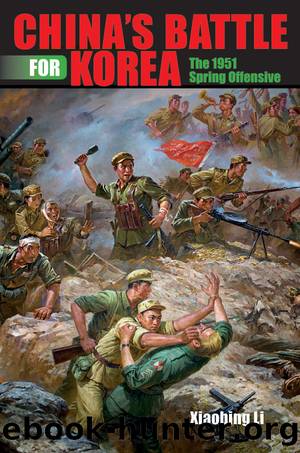China's Battle for Korea by Xiaobing Li

Author:Xiaobing Li [Li, Xiaobing]
Language: eng
Format: epub
Tags: History, Military, Korean War
ISBN: 9780253011633
Google: EIqbBAAAQBAJ
Publisher: Indiana University Press
Published: 2014-05-28T01:41:26+00:00
STALEMATE: TRENCH WARFARE AND TUNNEL DEFENSE
During the Spring Offensive, from April 22 to June 10, 1951, the CPVF based its operations on a conventional approach: it aimed to annihilate complete UNF units, such as an entire division or brigade. But before the end of the campaign, Chinese leaders realized that this practice had proved ineffective in Korea, where they faced a technically superior force. In a telegram of May 26, Mao agreed with Peng that âall the past campaigns have proved it difficult for our forces to accomplish their tasks of annihilating several U.S. divisions, or one division, or even one regiment, after they were encircled by our forces through strategic and tactical flanking operations.â6 Clearly, the battered CPVF troops lacked the firepower to break through the UNF lines through either surprise attacks or force of numbers. Mao came up with a new tacticââeating sticky candy bit by bitââor attrition tactics to eliminate UNF troops bit by bit.7 Under this guideline, the CPVF adopted a different fighting system that focused on more cautious defensive strategies and tactics. Their planning transformed their system from large-scale operations into piecemeal warfare.
After the Spring Offensive, the CCP Central Committee held a meeting in Beijing to discuss the CPVFâs next step. Most committee members considered it proper that the CPVF should stop at the 38th Parallel and conduct limited offensive operations. The Chinese leaders agreed that China should begin truce talks while continuing to fight a defensive war so as to work toward a negotiated settlement. Nie Rongzhen concurred with this view. The acting chief of the PLAâs General Staff believed that âwe had already achieved our political goal, i.e., that the enemy should be driven out of northern Korea. Our pausing at the 38th Parallel, in fact, was a return to the pre-war status quo. This would be easily accepted by all the parties in the war.â8 The military forces on the battleground had reached a new balance: stalemate.
In contrast to the situations the Chinese had faced in both WWII and the Chinese Civil War, in Korea it was difficult for either side to overpower its opponent completely. On the UNF side, even if the firepower and troops to drive the Chinese back to the Yalu were available, the will to do so was lacking. Although Matthew Ridgway believed that the U.S. Eighth Army, if it had been ordered to do so, âcould have pushed right on to the Yalu in the spring of 1951,â he also believed the âprice for such a drive would have been far too high.â9 In June James Van Fleet ordered limited operations to consolidate UNF positions, but nothing more. Unless one side or the other was willing to pay the cost in casualties and for the equipment required to carry out a major offensive, which would have been enormous, the war was effectively at a draw.10 On the Chinese side, heavy casualties in the spring, continuous shortages of supplies, and lack of firepower had made any new CPVF offensive almost impossible.
Download
This site does not store any files on its server. We only index and link to content provided by other sites. Please contact the content providers to delete copyright contents if any and email us, we'll remove relevant links or contents immediately.
| Automotive | Engineering |
| Transportation |
Machine Learning at Scale with H2O by Gregory Keys | David Whiting(4183)
Never by Ken Follett(3794)
Urban Outlaw by Magnus Walker(3342)
OPNsense Beginner to Professional by Julio Cesar Bueno de Camargo(3251)
Sapiens and Homo Deus by Yuval Noah Harari(2987)
Will by Will Smith(2793)
A Short History of Nearly Everything by Bryson Bill(2629)
Hooked: A Dark, Contemporary Romance (Never After Series) by Emily McIntire(2502)
Rationality by Steven Pinker(2291)
Borders by unknow(2229)
The Becoming by Nora Roberts(2088)
Holy Bible (NIV) by Zondervan(2087)
The One Percenter Encyclopedia by Bill Hayes(1787)
HBR's 10 Must Reads 2022 by Harvard Business Review(1777)
Freedom by Sonny Barger(1772)
A Short History of War by Jeremy Black(1762)
Five Ways to Fall by K.A. Tucker(1700)
Go Tell the Bees That I Am Gone by Diana Gabaldon(1687)
Girls Auto Clinic Glove Box Guide by Patrice Banks(1685)
